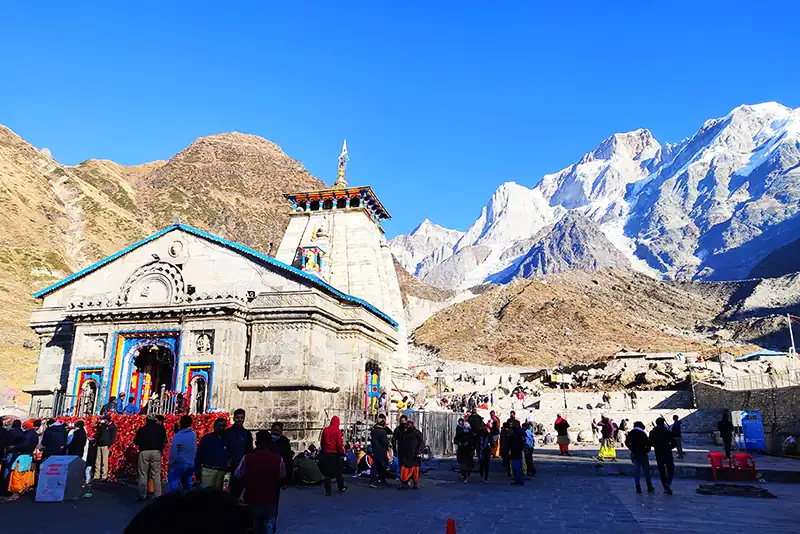Heavenly abode of Lord Shiva, nestled amidst the Himalayas, Kedarnath beckons pilgrims and adventurers alike with its ethereal charm. As one of the most revered pilgrimage sites in India, Kedarnath holds not only religious significance but also serves as a captivating destination for nature enthusiasts. Join us as we embark on a soul-stirring expedition to this divine sanctuary.
1. A Glimpse into the Spiritual Legacy
Located in the Rudraprayag district of Uttarakhand, Kedarnath finds its mention in ancient Hindu texts and scriptures dating back centuries. According to mythology, the Pandavas, from the epic Mahabharata, sought penance here to seek Lord Shiva’s blessings and absolution for the Kurukshetra war’s sins. The temple of Kedarnath, believed to be built by the legendary Adi Shankaracharya in the 8th century, stands as a testament to this ancient history, making it an essential pilgrimage site for devout Hindus.
2. The Journey Begins: Getting There
The journey to Kedarnath is an adventure in itself. Depending on your starting point, you may have to reach the town of Gaurikund, which serves as the base for the trek to the temple. From major cities like Delhi, Haridwar, or Rishikesh, one can avail of buses or hire private taxis to reach Gaurikund. The road leading to Gaurikund is a picturesque drive through lush green valleys and meandering rivers, offering a sneak peek into the mesmerizing landscapes that lie ahead.
3. The Sacred Trek
From Gaurikund, the real adventure begins – the 14 km trek to Kedarnath. The path meanders along the Mandakini River, encompassing breathtaking views of snow-capped peaks, cascading waterfalls, and verdant meadows. Though the trek can be physically demanding, the enthusiasm of fellow pilgrims and the serenity of the surroundings keep you motivated. There are also options for pony and palanquin services for those who find the trek challenging.
4. Amidst Divinity: Kedarnath Temple
As you approach the temple, the air becomes filled with an aura of divinity and devotion. The Kedarnath Temple stands majestically against the backdrop of the imposing Kedarnath Peak (also known as Kedar Dome) at an elevation of approximately 3,583 meters (11,755 feet) above sea level. The temple’s stone architecture and intricate carvings add to its timeless allure.
5. Unparalleled Spiritual Experience
Visiting Kedarnath is not just about seeking the blessings of the divine; it’s an opportunity to connect with nature and find solace in its tranquility. The aura of spirituality permeates every corner, as pilgrims chant hymns and prayers echo throughout the region. Witnessing the evening aarti (ritual offering to deities) at the temple is an experience that stays etched in the heart forever.
6. Beyond the Temple: Exploring the Beauty
While the temple is the primary attraction, Kedarnath has much more to offer. For those with an adventurous spirit, the region is a paradise for trekkers and nature lovers. Excursions to nearby places like Chorabari Tal (Gandhi Sarovar), Vasuki Tal, and the Vasuki Glacier add another layer of adventure to the journey.
7. Environmental Conservation: A Shared Responsibility
With the increasing number of visitors each year, it is essential to preserve the sanctity and ecological balance of this pristine region. As responsible travelers, we must ensure that we follow eco-friendly practices, avoid littering, and respect the local culture and customs.
8. The Return Journey
After a soul-enriching experience at Kedarnath, the return journey to Gaurikund allows you to savor the memories you have gathered. It’s a time to reflect on the spiritual transformation and a reminder of the vast beauty that the Himalayas bestow upon us.
In Conclusion
Kedarnath is more than just a pilgrimage; it’s a spiritual and emotional journey that transcends time and space. It’s an encounter with divinity and a merging with nature’s grandeur. So, if you’re seeking a spiritual awakening amidst the lap of the Himalayas, set your sights on Kedarnath, and let the enchanting journey unfold before you. As the famous saying goes, “To journey in the mountains is to nourish the soul.”


